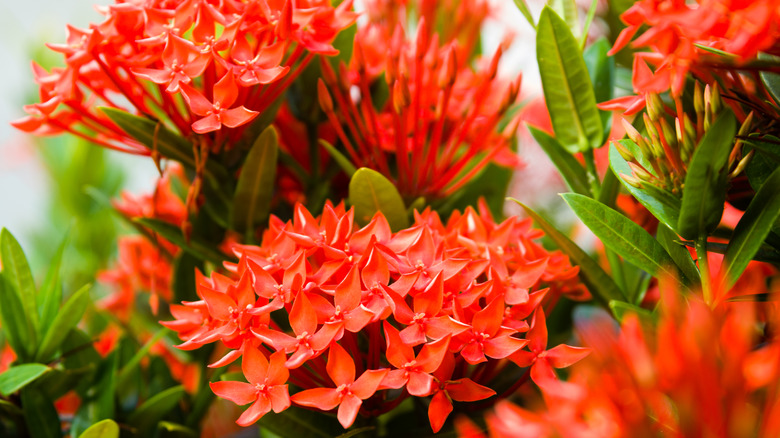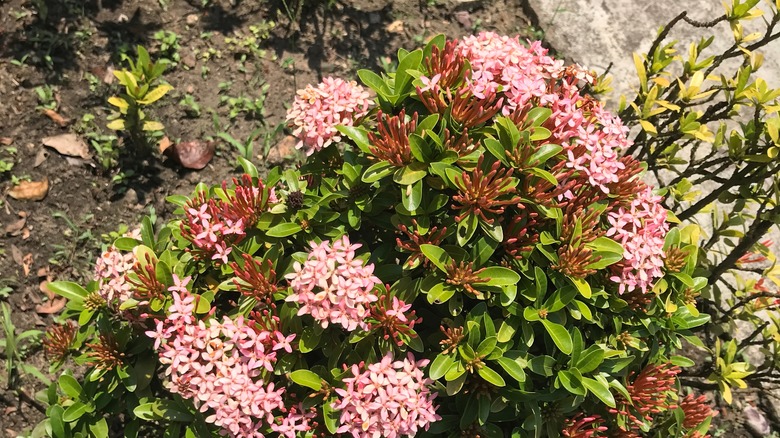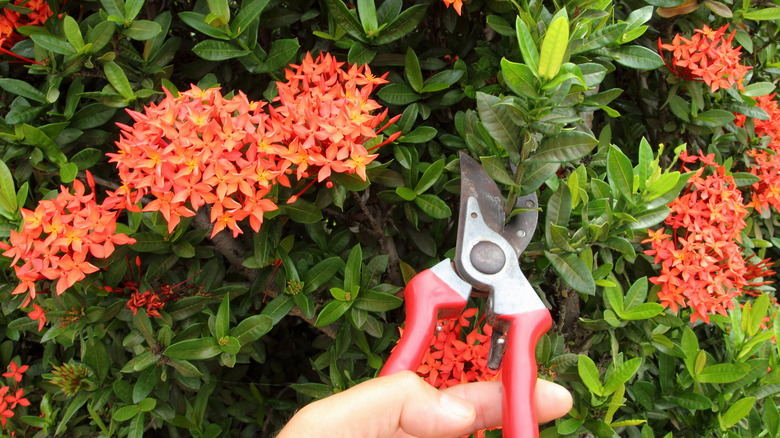The Best Way To Plant West Indian Jasmine For The Most Stunning Blooms Possible
West Indian jasmine (Ixora coccinea) is a stunning perennial, shrub, or evergreen, depending on the variety. Sometimes called jungle geranium due to its stunning red color and green foliage, this plant is noted for its big, bright blooms at any time of the year, depending on the climate. If you are growing West Indian jasmine plants and hope to have the most impressive blooms possible, ensure you avoid low-temperature exposure and pinch off old blooms. With a few steps to support this plant's somewhat temperamental needs, you may be able to get larger and more vibrant growth from it.
Depending on the specific type, this plant can grow up to 6 feet in height and up to 5 feet wide, making it a substantial statement piece in your warm climate garden. However, with specific strategies, you can limit its growth to keep it at an appropriate size for your kitchen windowsill or indoor greenhouse. There are a few things that make this plant special, but nothing is more impressive than the large flowering clusters. Though red is common, there can also be other varieties, including orange, yellow, and a beautiful white and cream, near-pink color. Some varieties are also bright pink. With over 560 plant species in this family, these overall low-maintenance plants can thrive in the right climate and with a bit of extra attention.
Plant them in the best environment
Ideally, this plant does best in warm areas in direct sunlight. They don't do well in areas where temperatures are very low, like deeply shaded areas or where there's a significant cold draft. If you're bringing them into your home, avoid areas near the air vents, for example. Once in place, don't move them around the home either. They will adapt to the surrounding environment (unless it is too harsh for them). You can bring potted West Indian jasmine into the home after a warm season spent outdoors. The key here is to move them in prior to temperatures becoming drafty and cold to preserve their need for warmth. They also need direct sunlight for at least six hours each day. Some varieties benefit from full sun most of the year.
There are a few more steps to create the right environment for West Indian jasmine. Select an area that offers enough room for your selected species. Avoid planting it too close to hardscape surfaces, like the foundation of a home or the sidewalk. The high pH of the concrete will make the surrounding soil too alkaline. If the soil in the area you plan to plant is already alkaline, consider supplementing it since these plants do best in acidic soil. They benefit from organic, highly fertile soil so supplementing with fertilizer may be necessary to encourage proper growth and bloom development.
Encouraging big, bold blooms by pinching off the old
In addition to the right environment, West Indian jasmine also needs a bit of care throughout the growing and off-season to give it the ability to bloom big and continuously. Part of that care includes pinching off blooms once they begin to dry out and wither which will allow the plant to focus more heavily on the next blooms rather than restoring the old. By removing the old growth, you'll see new blooms replace them. To do this, just remove the first few inches of the plants. Do this right above a set of leaves to encourage the plant's stem to continue growing from that area.
The shrub varieties of the plant do benefit from some pruning and shaping. The best time of year to prune your West Indian jasmine is the end of winter before the plant begins to flower. This plant also does fairly well when shaping it, which means if you want a very specific look or abstract design, you may be able to achieve this here. As a slower-growing plant, you will need to shape it infrequently to encourage that controlled growth. Note that if it seems to have ample foliage growth but few blooms, this could indicate a high nitrogen level in the soil. Use a flower fertilizer to balance things out.


